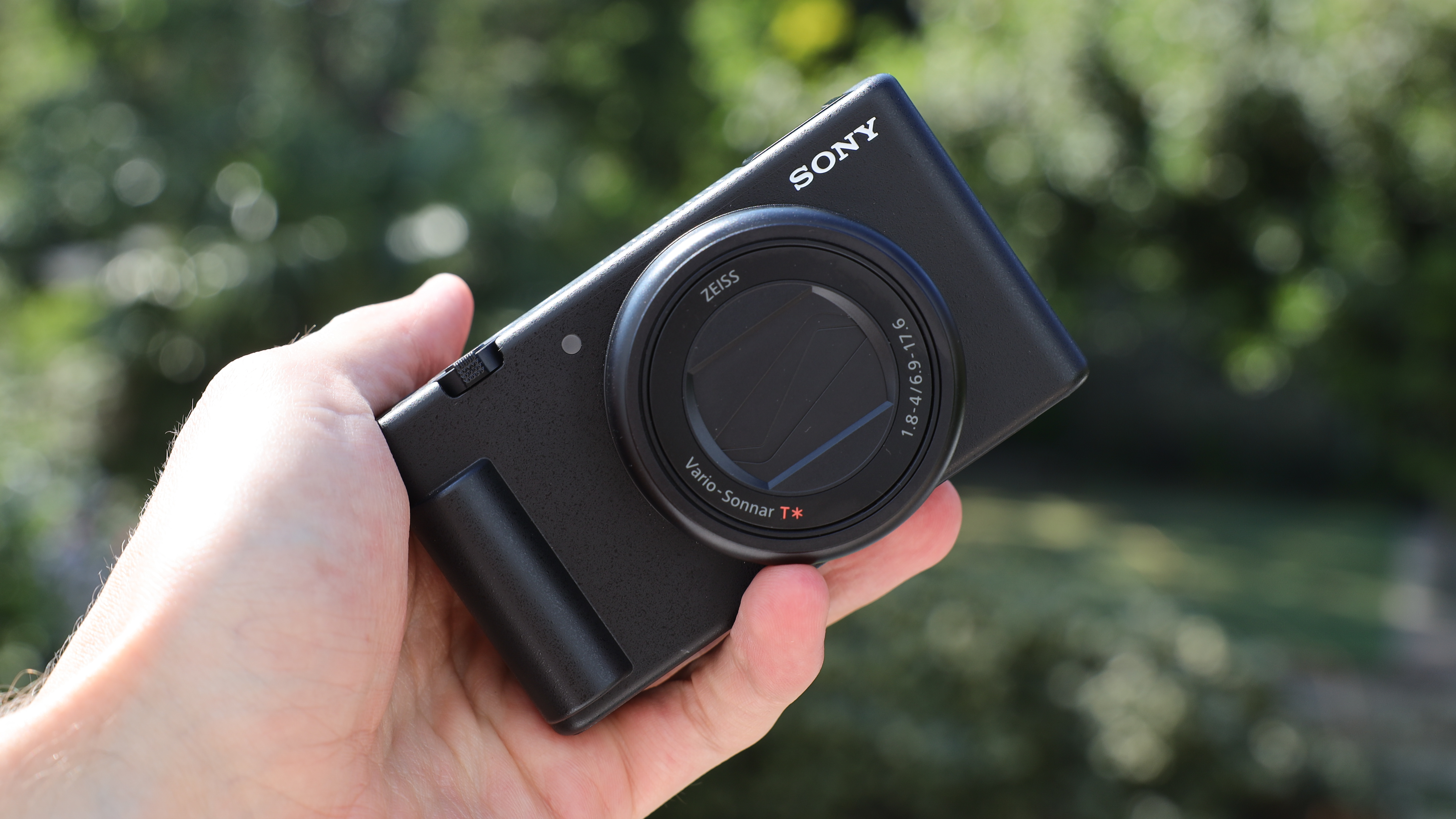
The Sony ZV range has been around for a few years now, first introduced to jump into the rapidly growing segment of vlogging and social content creation. The ZV range aims to offer small and compact systems that produce better content than what is achievable with the phone already in your pocket.
Sony kicked off the range with the original Sony ZV-1, and in just a few years we now have five unique cameras in the lineup, suggesting that it has turned out to be a financial winner for Sony. Sony is now releasing a sequel to the ZV-1, fittingly named the Sony ZV-1 II, although, from the specs sheet, it is more of a revision than a revolution, and how does it stack up against the original model?
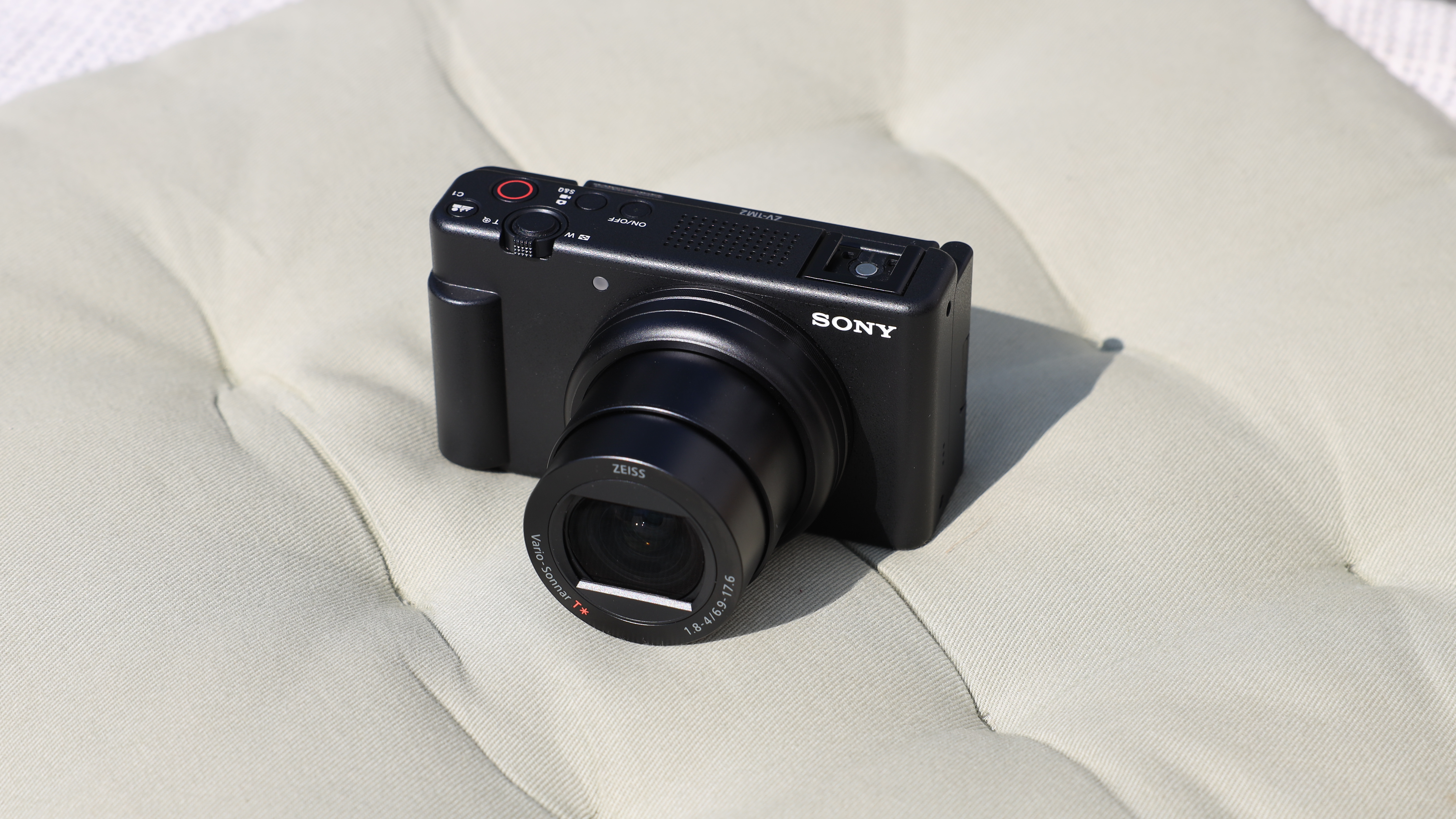
Sony ZV-1 II: Specifications
Sensor: 20MP 1″ BSI-CMOS Sensor
Lens: 18-50mm f/1.8-4.0
ISO: 125 - 12800 (expandable 80 - 25600)
Screen: 3-in fully articulated touchscreen
Shooting Speed: 24fps continuous shooting
Video: 4K (3840x2160), 1080p FHD, FHD 720p 960fps high-speed video
Connectivity: Bluetooth, WiFi
Size: 106 x 60 x 47 mm
Weight: 292g
Sony ZV-1 II: Key Features
The main feature separating the new from the previous model is the ZV-1 II’s new wider angle zoom lens. The 18mm lens is newly designed for vlogging, selfies and group shots at arm's length, while the 50mm focal length at the other end of the range is ideal for portraits and product shots. The lens keeps its maximum aperture of f/1.8 at the wide end, but drops to f/4 when zooming in. While the ZV-1 is not image stabilized, it does offer Sony’s Active digital stabilization for smoother footage at a slight crop to the footage. And behind the lens, the camera has auto-tracking for humans and animals including Eye AF for both.
The ZV-1 II has a built-in 3-Capsule microphone for better sound recording, which can intelligently switch the direction of recording from ‘all directions’ to ‘front’ when the camera recognizes a human face in the frame, or you can also manually switch between ‘front’ and ‘rear’ directional recording. The camera also has digital noise reduction as well as a windscreen included in the box.
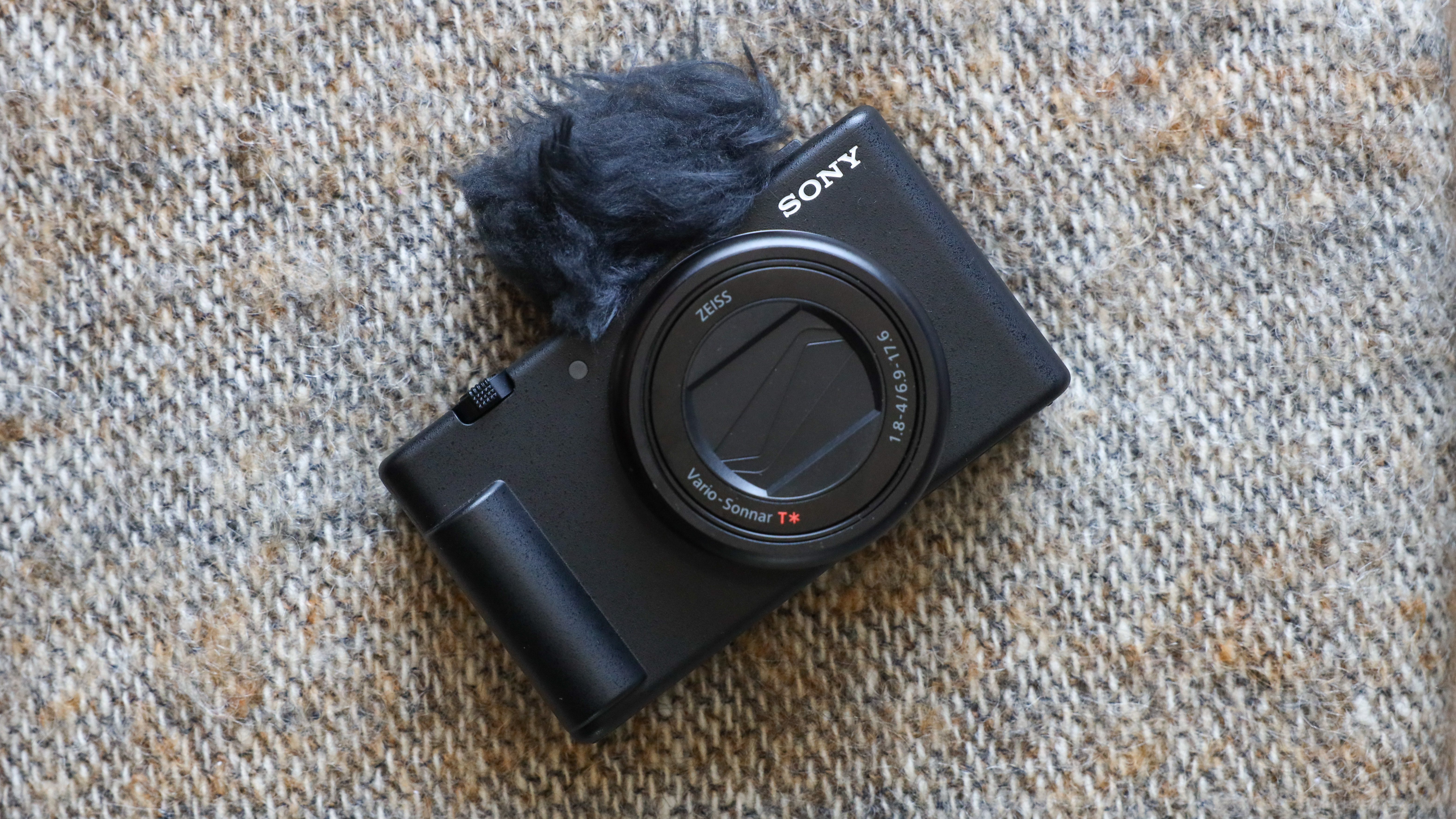
The ZV-1 II has a lot of features to make vlogging faster and easier including the option to select from five ‘Looks’ and four ‘Moods’ to change the overall style of your video without any complex editing. The ZV-1 II also has a Cinematic Vlog setting which sets the camera to Cinemascope and 24fps for professional-looking video at the touch of a button. These can all be controlled with new touchscreen menus which Sony claims are more intuitive than ever before.
Also a key feature for vloggers, the ZV-1 II offers a Product Showcase setting to automatically switch the camera’s focus when it detects a product being held up. The Bokeh Switch will also switch to a wider aperture and use digital blurring to get a soft blurred-out background, similar to professional camera footage. The ZV-1 also connects to the Creators’ App smartphone app via Bluetooth, so you can get your photos online fast, or use the app to control the camera from afar.
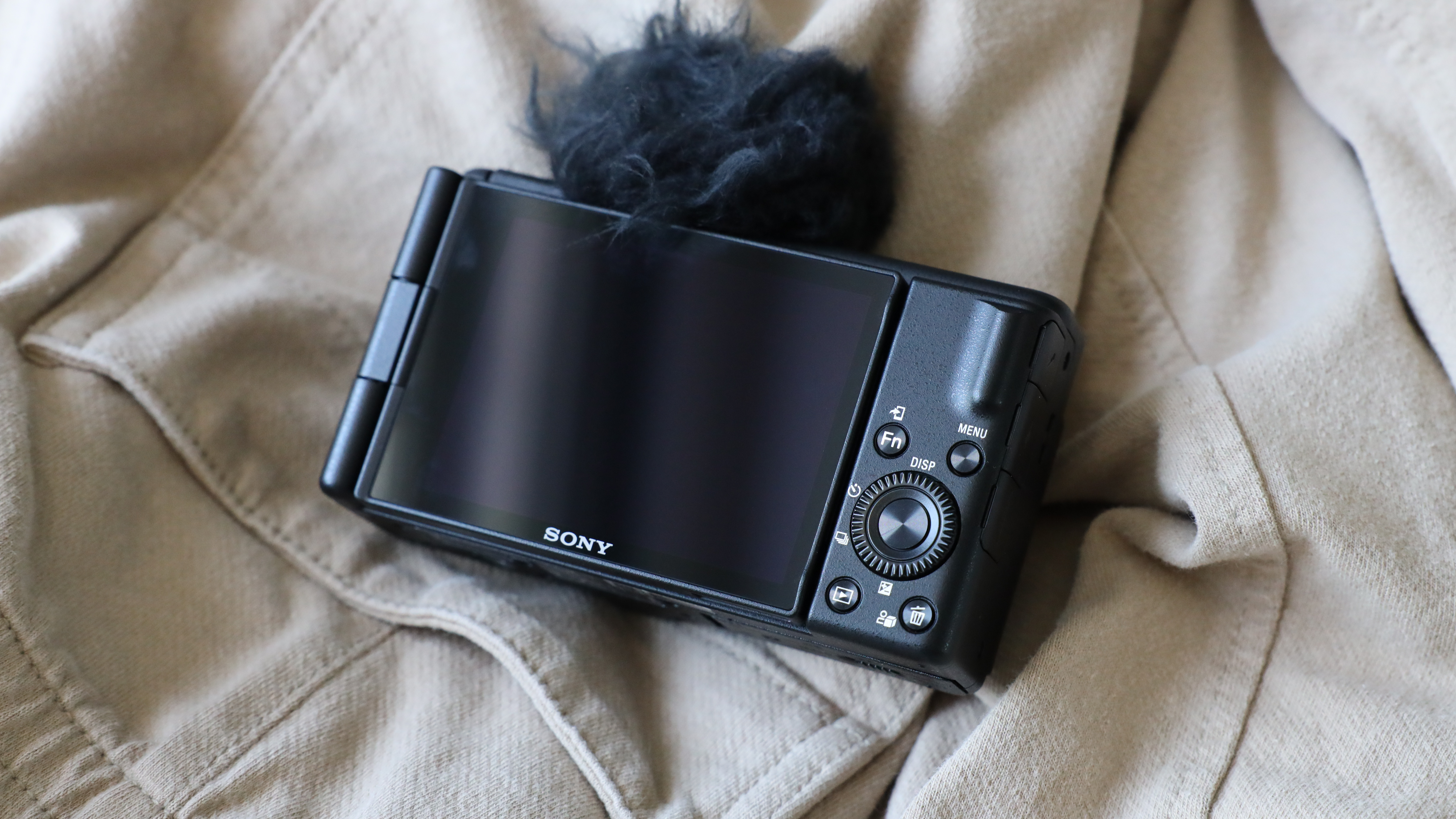
Sony ZV-1 II: Build & Handling
The ZV-1 II is tiny, when it arrived at my door I was almost convinced the box was too small to hold the camera. This is the main selling point for the ZV-1 II, it's a discreet little camera that can slide into a pocket or a small bag and go anywhere and everywhere with you. It is just about enough to hold onto, it has the smallest of grips that is just about enough to catch a finger on. Otherwise, the build and button layout is exactly the same as the ZV-1, which is no bad thing, as for a very compact camera, it offers a decent amount of buttons as well as a control wheel.
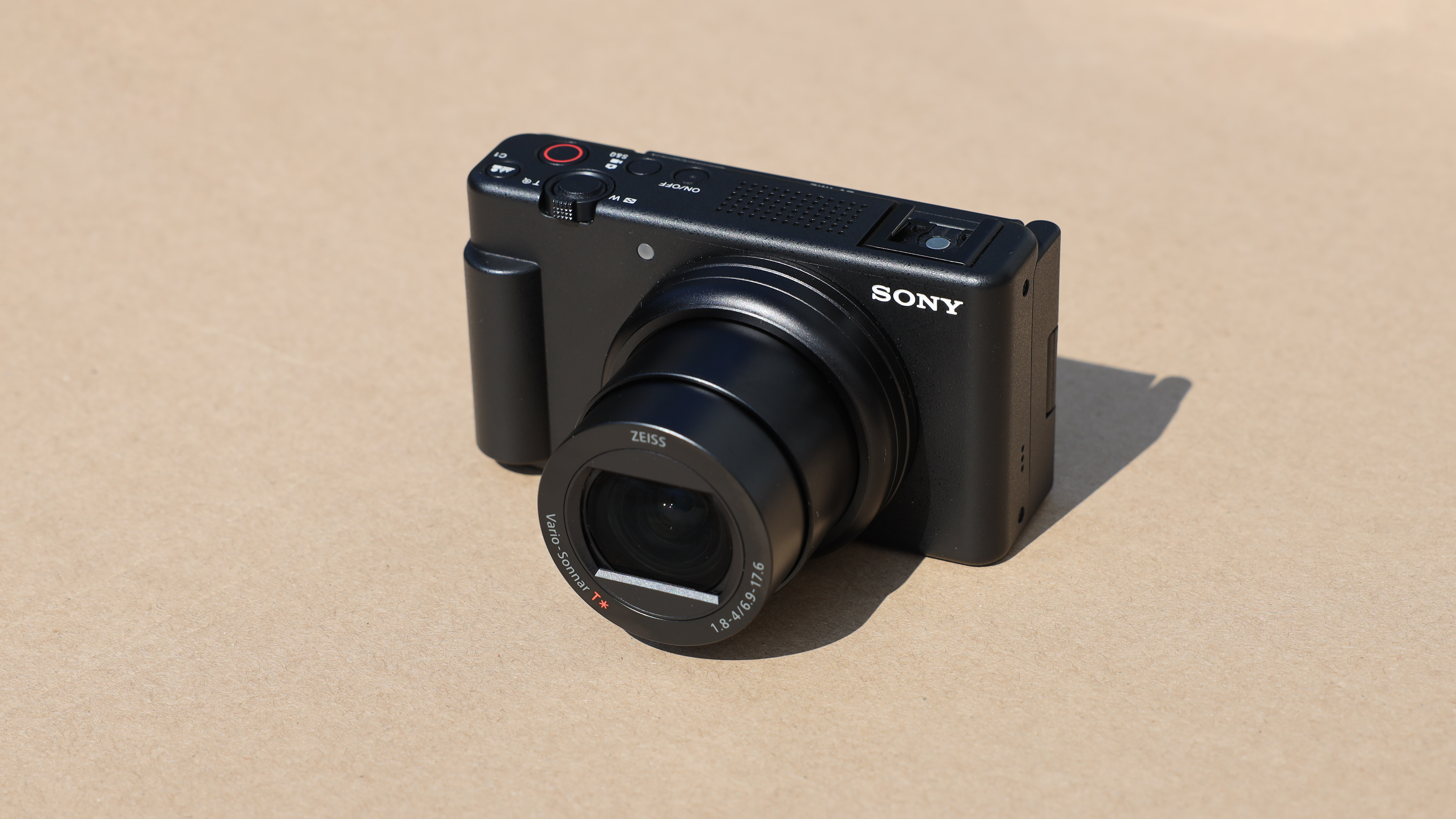
The camera comes with a windscreen or wind defender, or whatever we are calling it now, which slots into the camera hot shoe and gives pretty great wind suppression to the microphones when shooting outside. The tally light on the front of the camera is a useful feature for letting you know when you are recording, especially in glare where you can’t see the screen easily, although the screen also shows a red box during video recording.
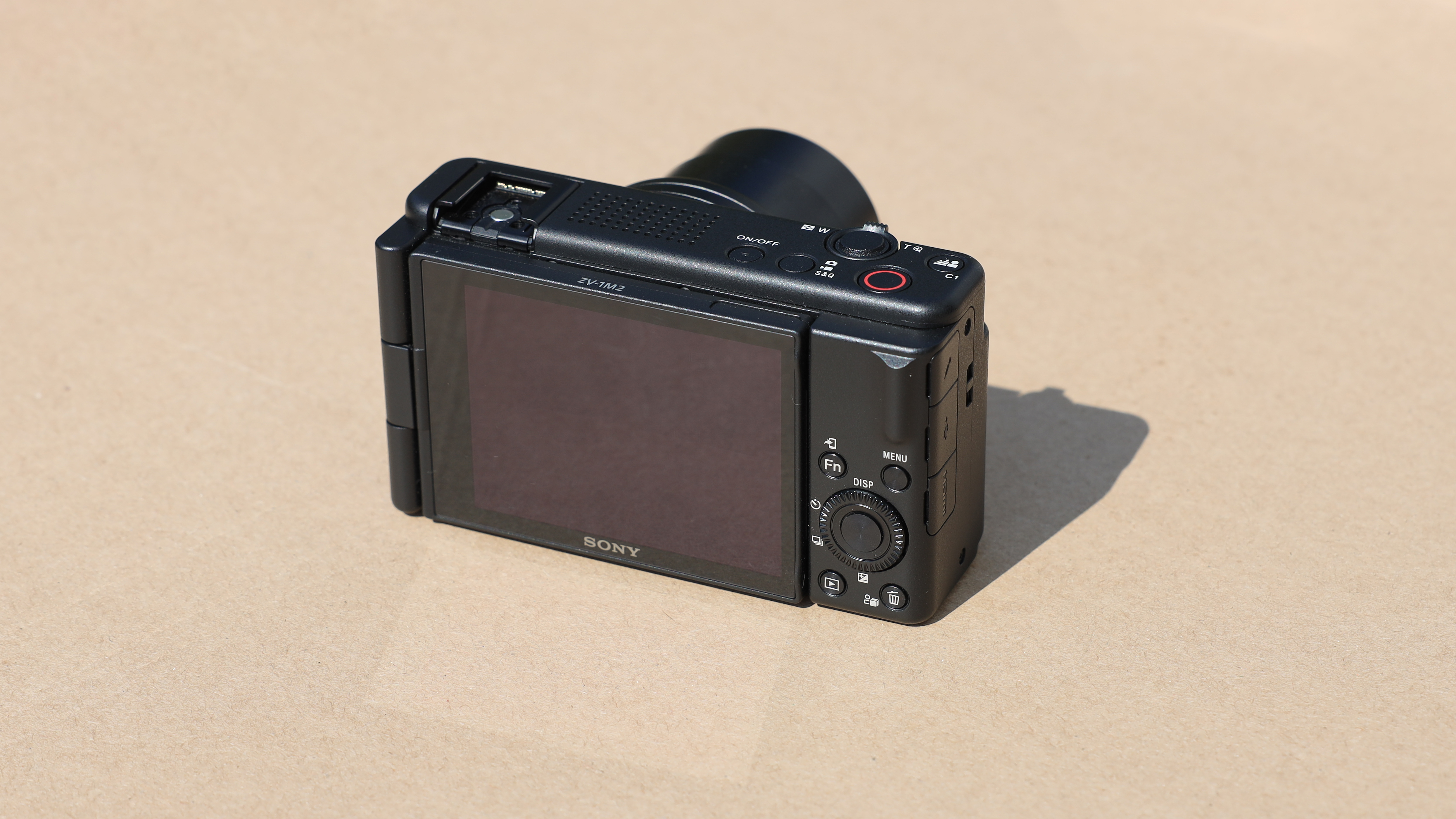
The lens actually extends a surprising amount from the body, I assumed that the reduced focal length might mean a more compact lens, the lens is not obtrusive and the camera is perfectly balanced even when extended. The lens is zoomed in and out using a zoom toggle on the top which has a delightful retro feel to it, but the zoom is smooth and quick enough that you won’t miss too much action.
Apart from the lens, the other big change from the previous version is the much-improved touch screen. The touch screen now allows you to control the whole camera versus the older version that had limited touch control in menus. This makes the camera so much more user-friendly, I found controlling the settings on the screen much easier and faster than using the buttons to dive into menus and brings it much more in line with what anyone stepping up from a smartphone will be expecting.
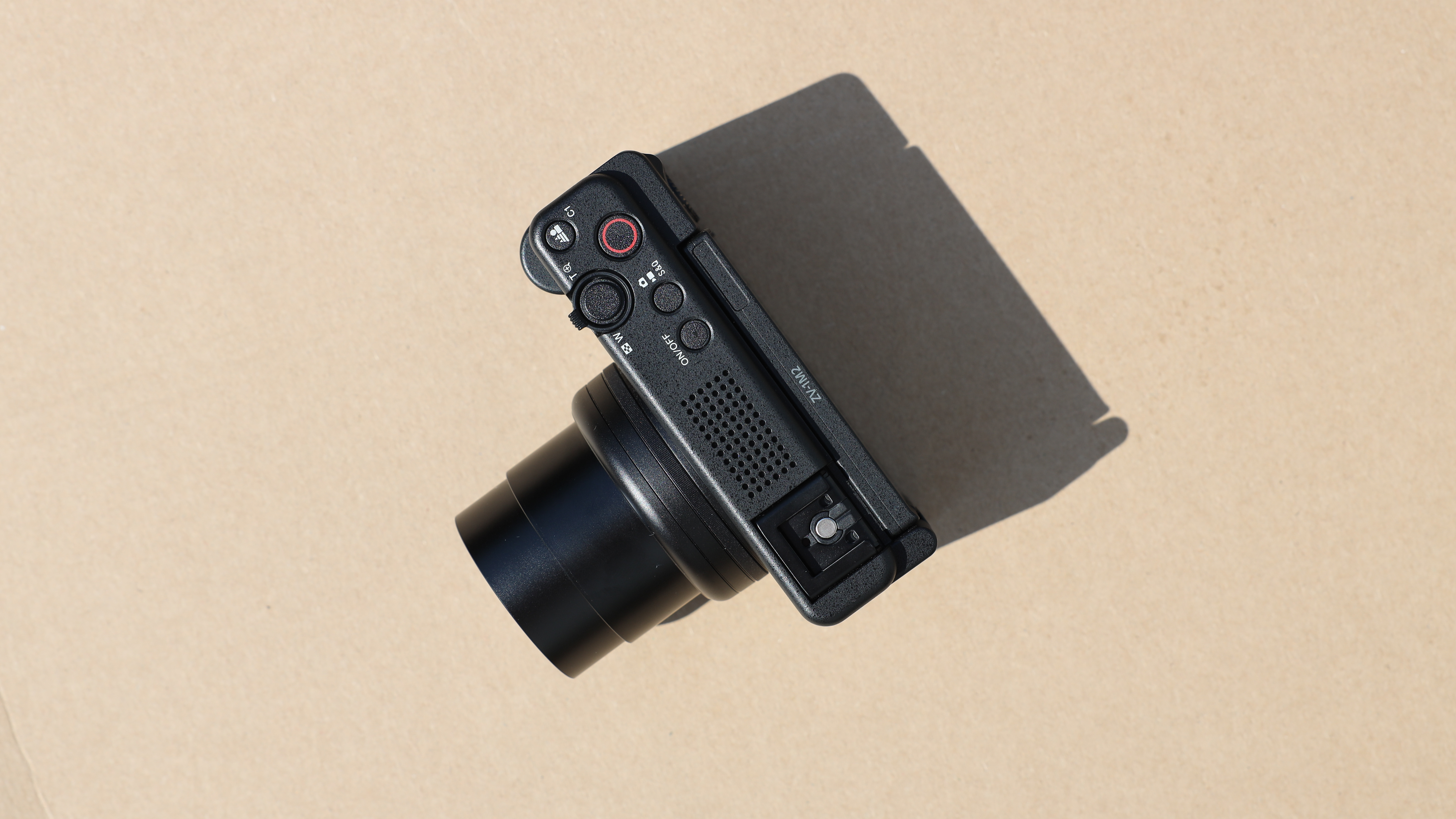
Sony ZV-1 II: Photo Performance
I can’t fault the performance of Sony’s 1-inch sensor in terms of photo performance as it met my expectations. The photos are very good, but are they noticeably better than what a phone with decent processing can do? Not really. The bigger sensor gives a slight advantage in low light and sharpness, but I couldn’t really tell the photos from the ZV-1 II apart from the same images on my Pixel 7 Pro in terms of image quality at full size.
It was only pixel peeping where I could notice a difference, as well as in the image processing, as both a phone and the ZV-1 II each processed their images very differently. The phone tries too hard to give you the perfect image, while ZV-1 II images are less processed-looking, especially when it comes to HDR, although I would argue that the purpose of the ZV-1 II is for quick ready-to-share images, so more aggressive smartphone-esque processing would be beneficial as bright areas lost a lot of detail in the ZV-1 II’s shots compared to the HDR phone images.

At the wide end, photos have a slight softness, especially near the edges, and in bright light, occasionally have a glowing ethereal quality to them, as you go through the zoom range, this sharpens up, and at 50mm, the image quality is very good, and if you can achieve some decent background blur if you are close to your subject. You can push the camera into digital zoom up to 2x (100mm), which actually produced equally good photos, with practically no perceptible difference in image quality.
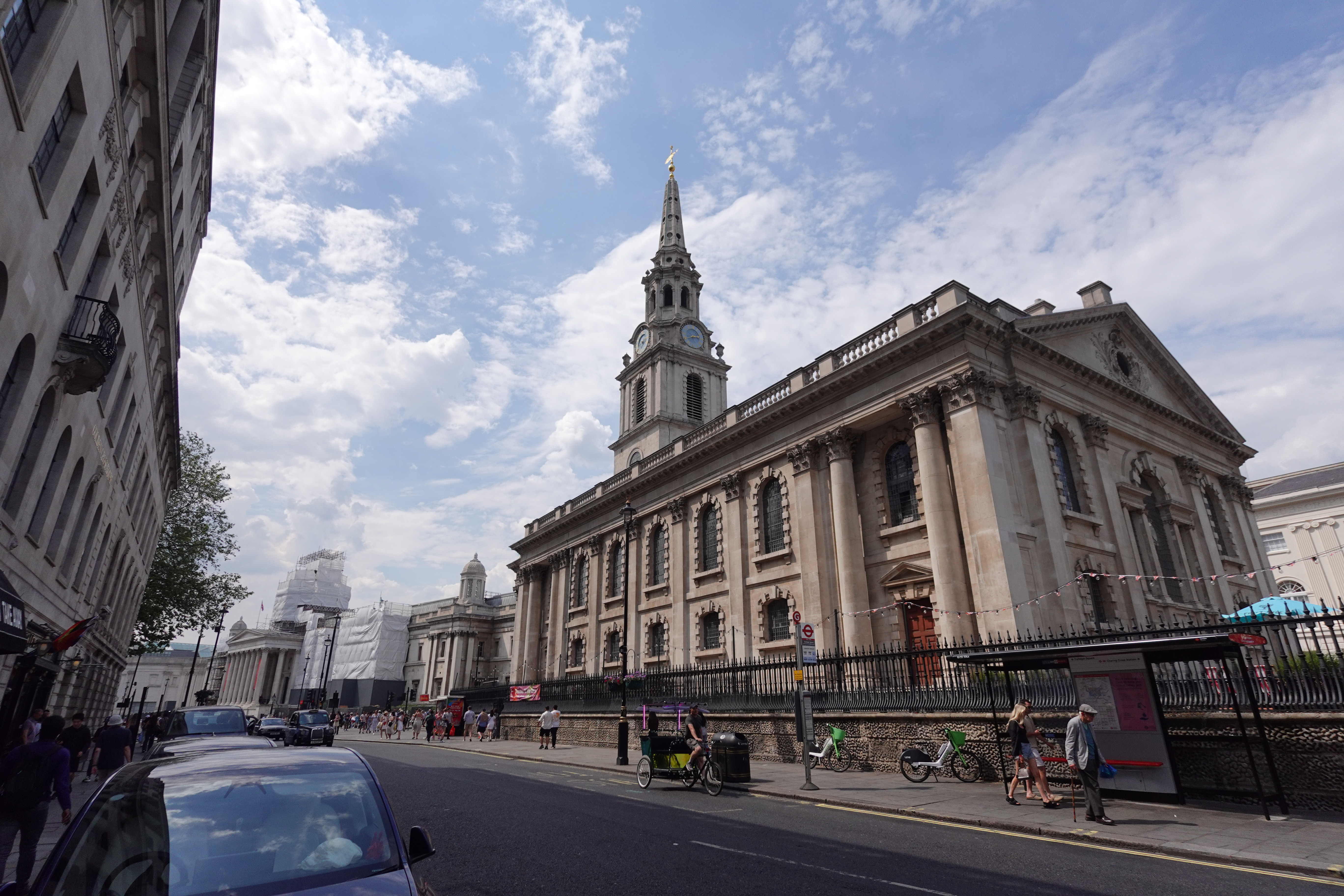
The ZV-1 II serves as a perfectly good stills camera if it happens to already be in your pocket, but if you are someone who wants to take stills as much as video, then there are much more compelling options that are not much larger or more complicated, and in some cases, more affordable. When compared to cameras with larger APS-C sensors, the ZV-1 II sensor size limitations become more apparent, my not much bigger Fujifilm X-E4 produced considerably better images.
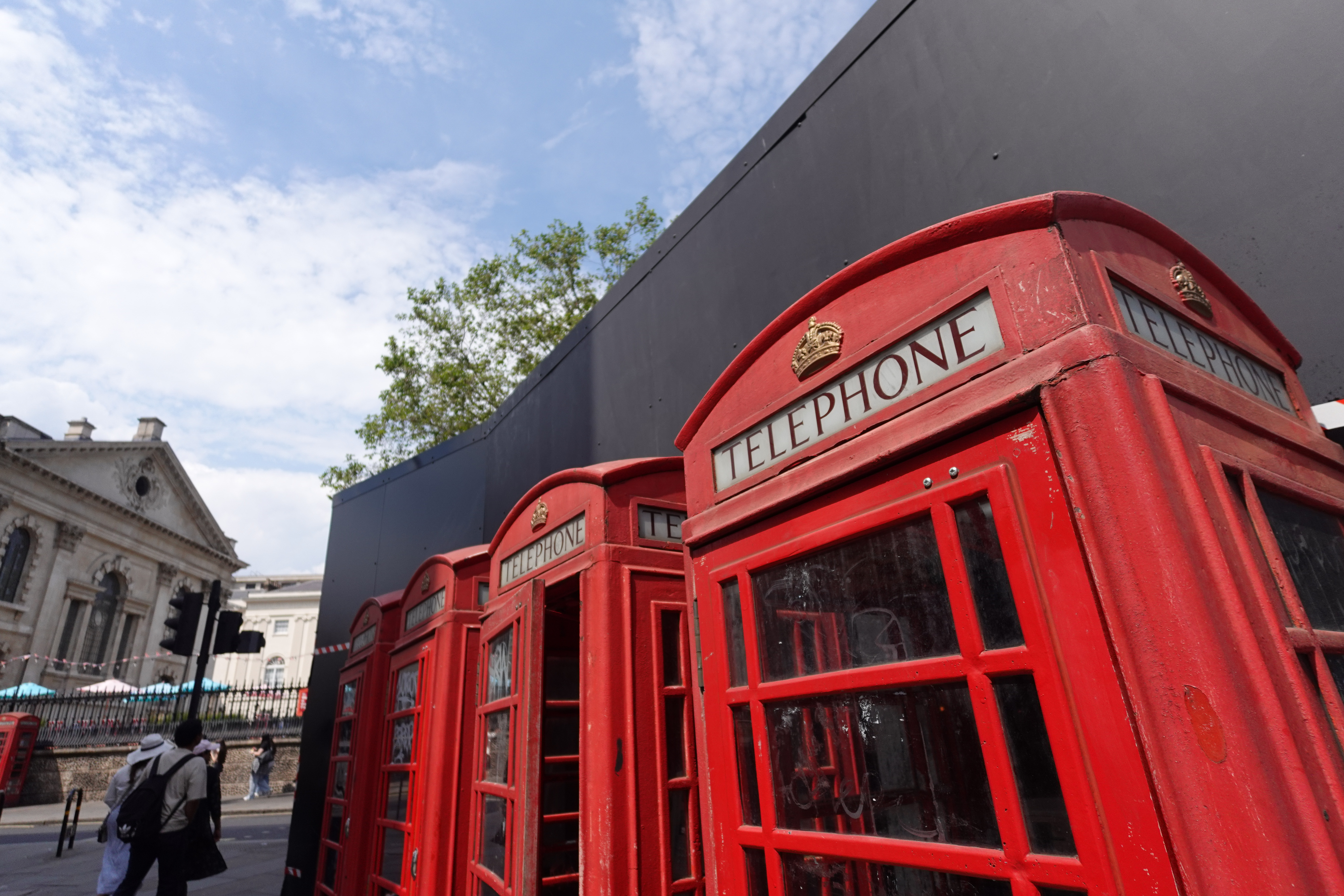
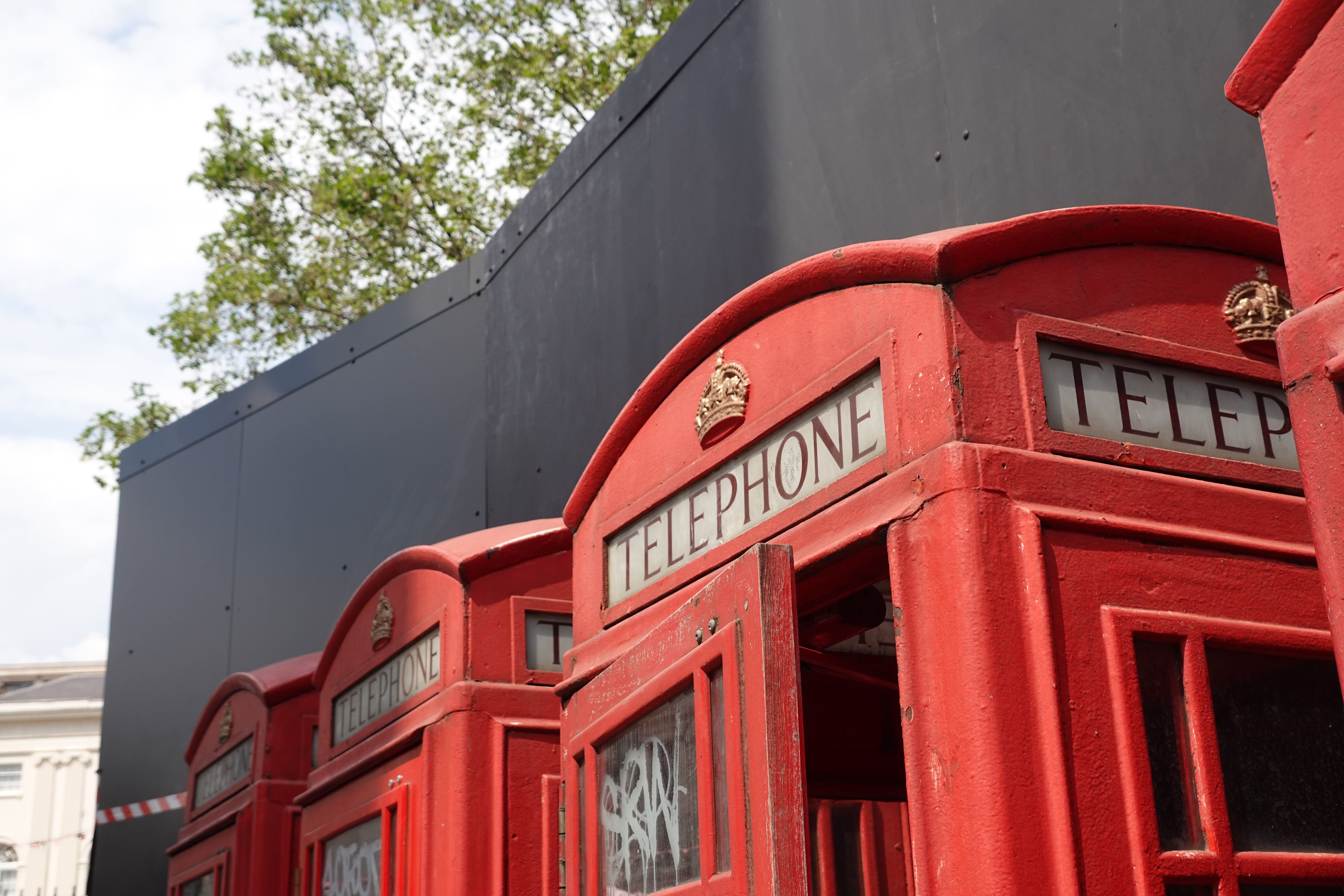
Sony ZV-1 II: Sample Images
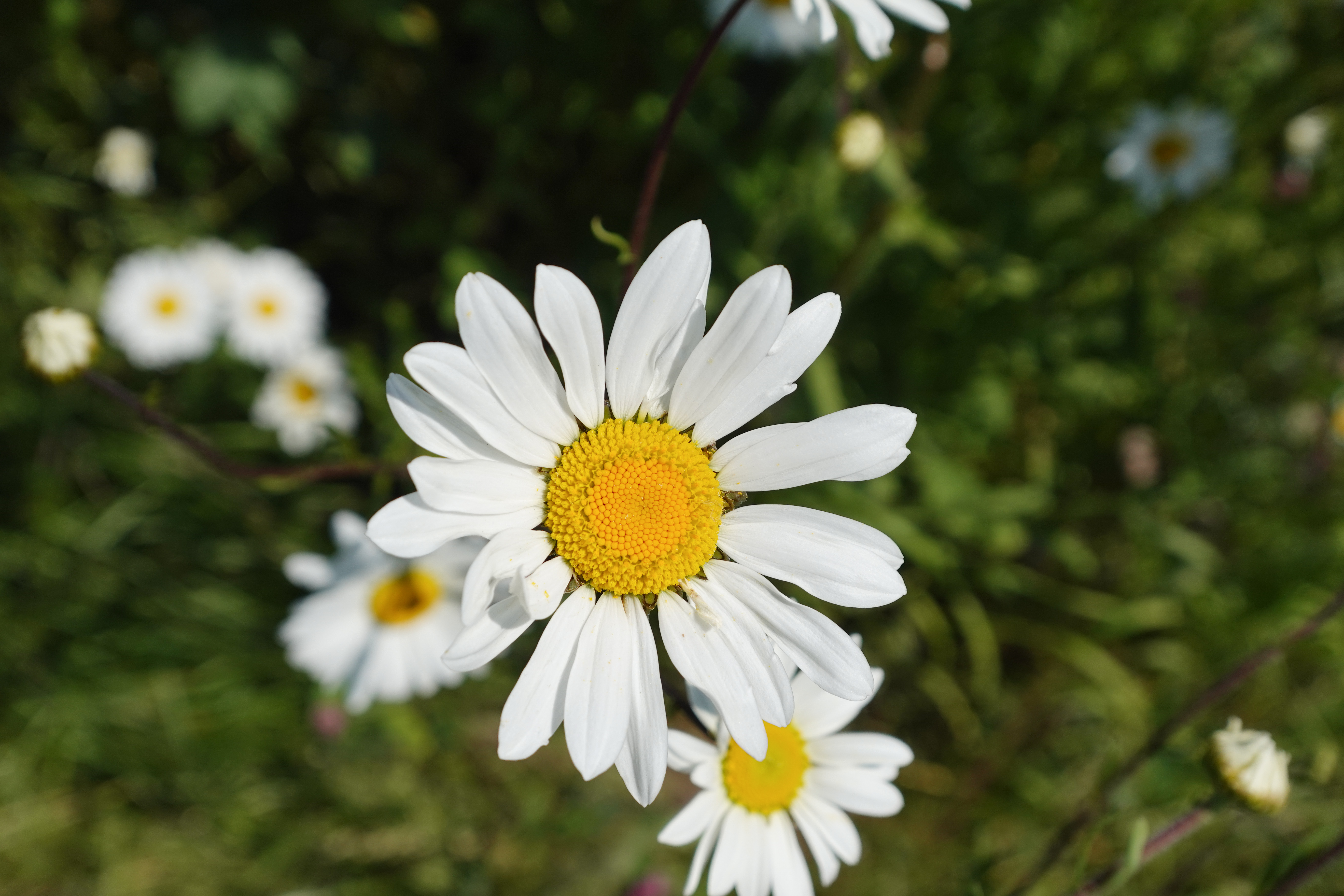
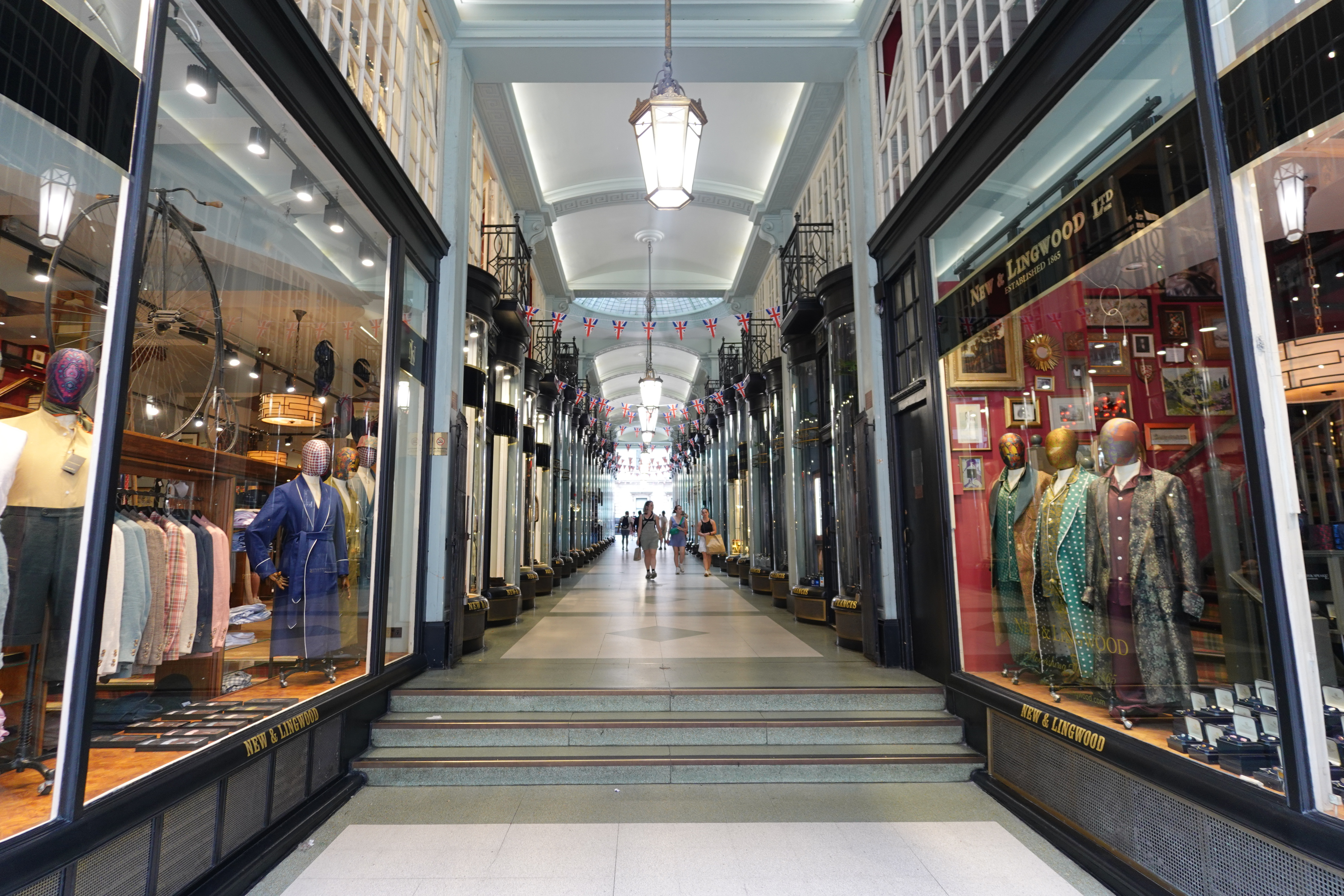
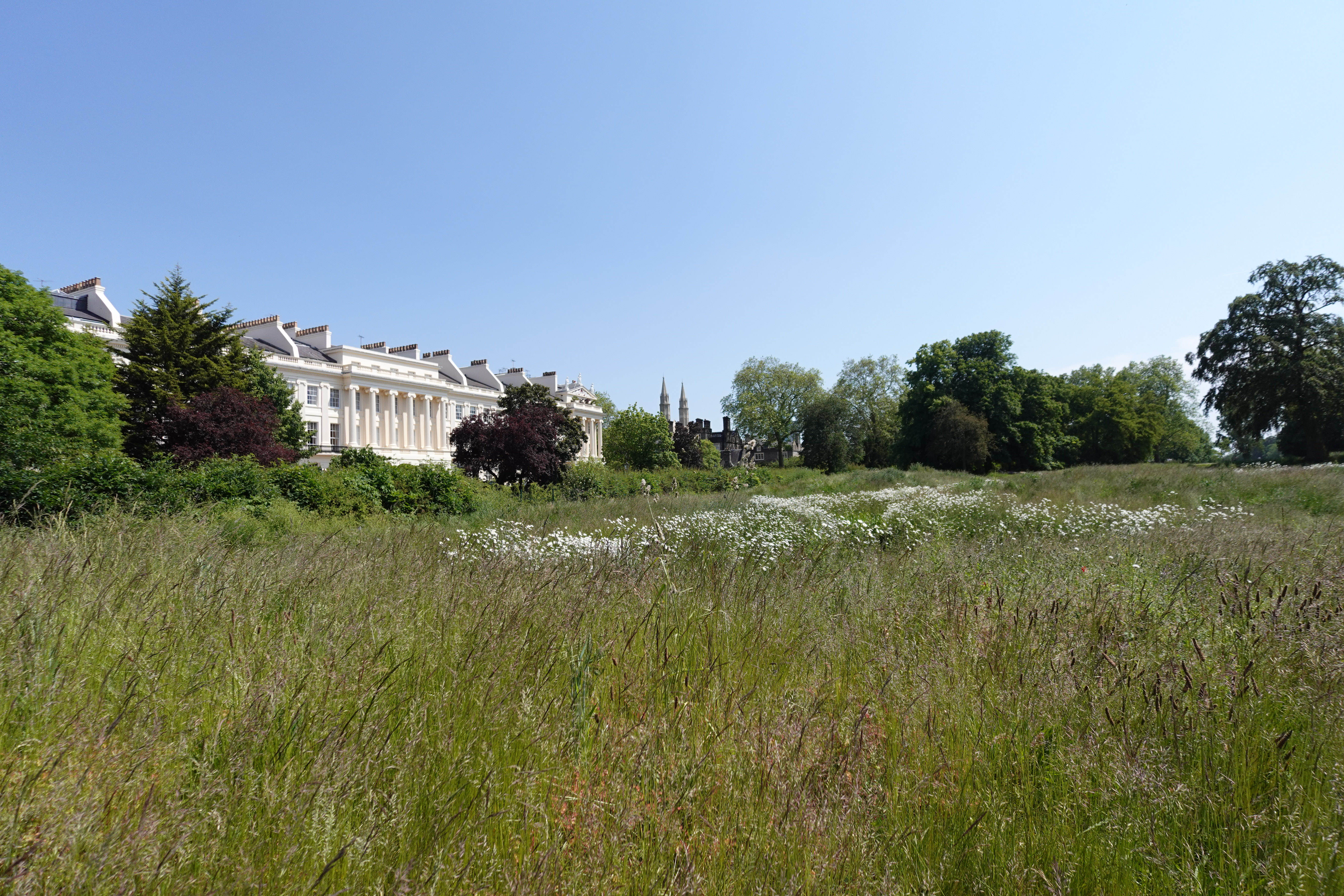
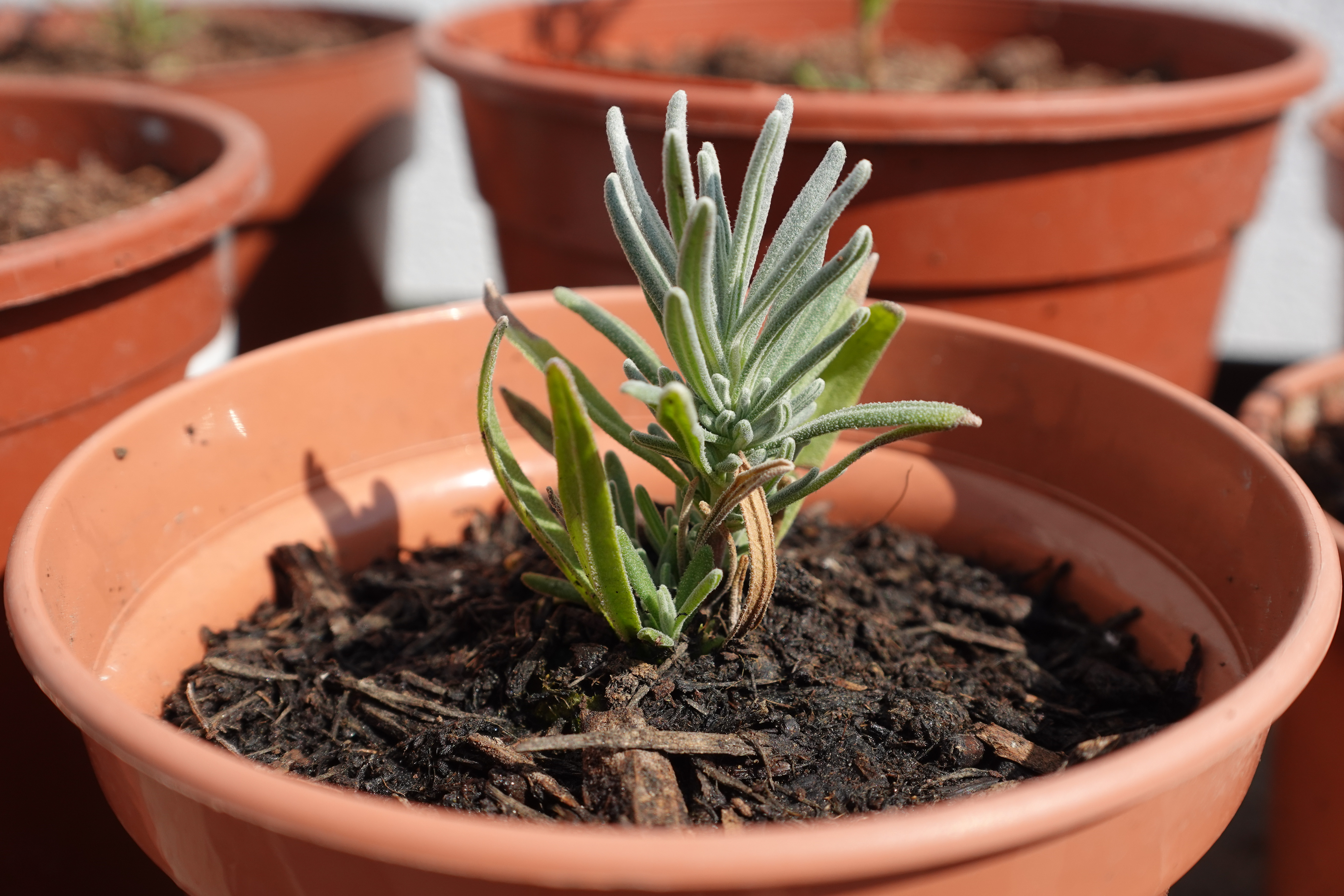
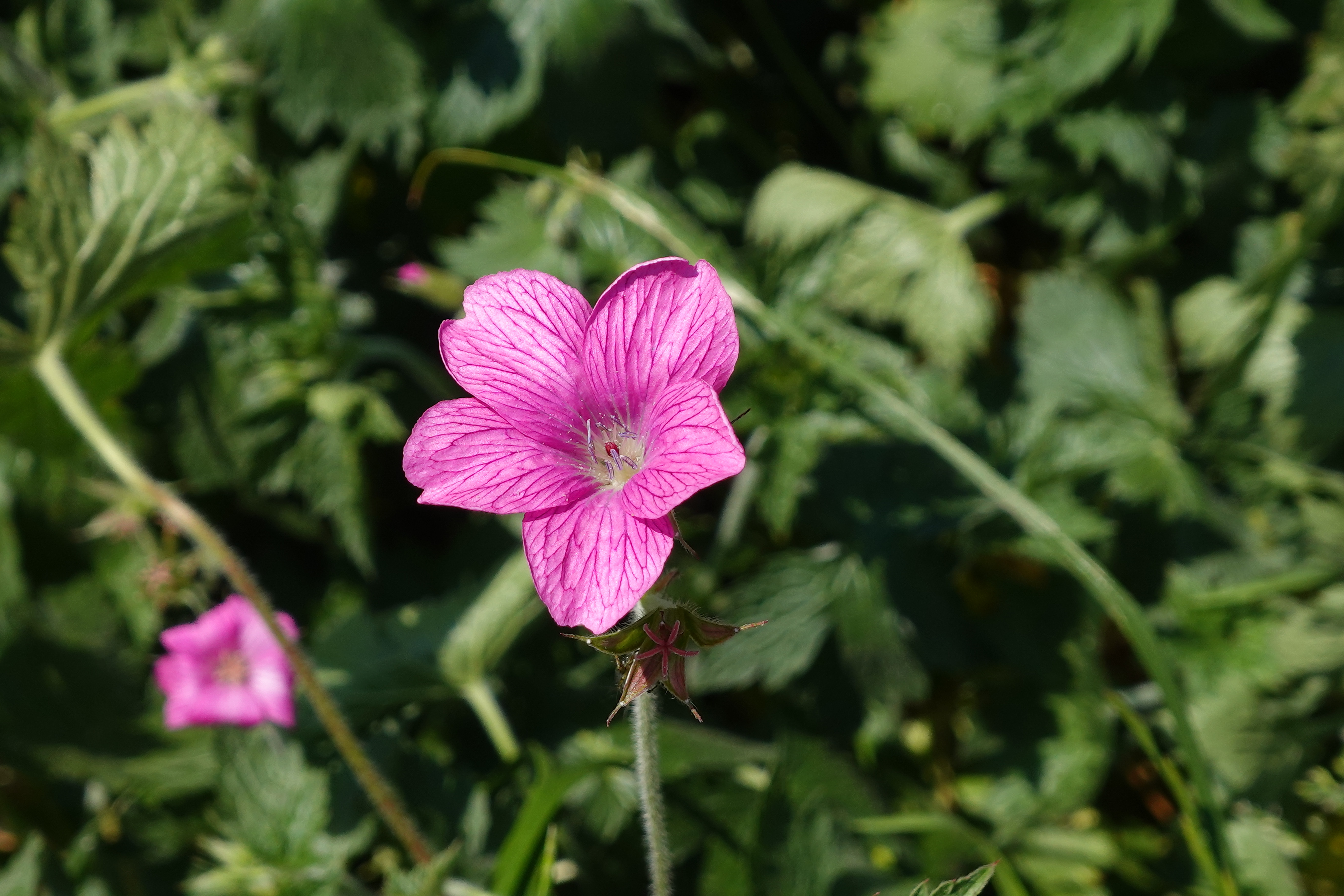



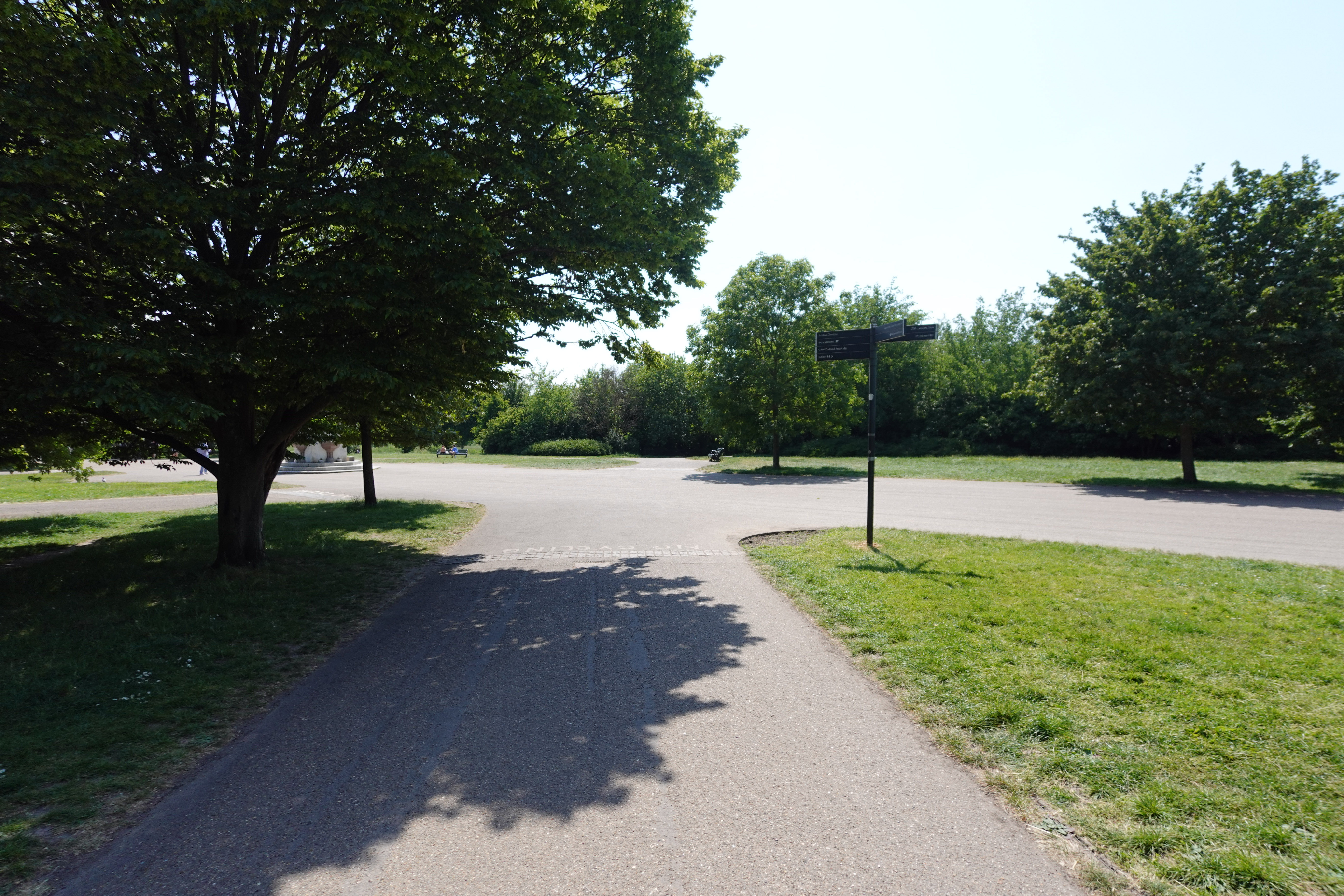
Sony ZV-1 II: Video Performance
Video performance on the ZV-1 II is great and in almost all cases surpasses what you can expect from a phone. The 1-inch sensor offers a more natural depth of field than a phone, while the ZV-1 II footage doesn’t look like a Hollywood production, it still blows even the latest cinematic video modes out of the water.
The 4K video from the Sony ZV-1 II is sharp and clear, and performance in low light is good, although better at wider angles, with the top end of the zoom range having a narrower aperture which pushes the ISO and noise a little higher. The camera's slightly ludicrous shutter speed is fun to play with, I enjoyed creating super slow-motion footage, which is still in a resolution just about passable for social media use.
One issue I did have with the video footage was even with Sony's Active digital stabilization, the footage was still a little jerky, and at times you can clearly see the digital image stabilization at work. While video quality might be better than a smartphone, when it comes to image stabilization, phones have the ZV-1 II beat.
Where the camera shines among other options on the market is with its focus on sound quality, the three-microphone array is excellent at picking up my voice with clarity and does a much better job than other cameras without Sony ZV in their name. Sure you can pop a little external mic on any other camera, but that doesn’t beat the simplicity of the all-in-one experience of the ZV-1 II.
Sony ZV-1 II: Lab results
The Sony ZV-1 II has no obvious direct rivals in the fixed lens compact camera sector, but for the same money there are plenty of APS-C interchangeable lens options available, many of which are also well suited to vlogging. There's the Canon EOS R50, plus its principle rival, the Nikon Z30. Even Sony has its own alternative to the ZV-1 II in the shape of the ZV-E10 - another small, vlogging-centric camera that even with a 16-50mm kit lens currently costs less than the ZV-1 II.
We test resolution using Imatest charts and software, and dynamic range and signal-to-noise ratio with DxO Analyzer.
Resolution (line widths/picture height):
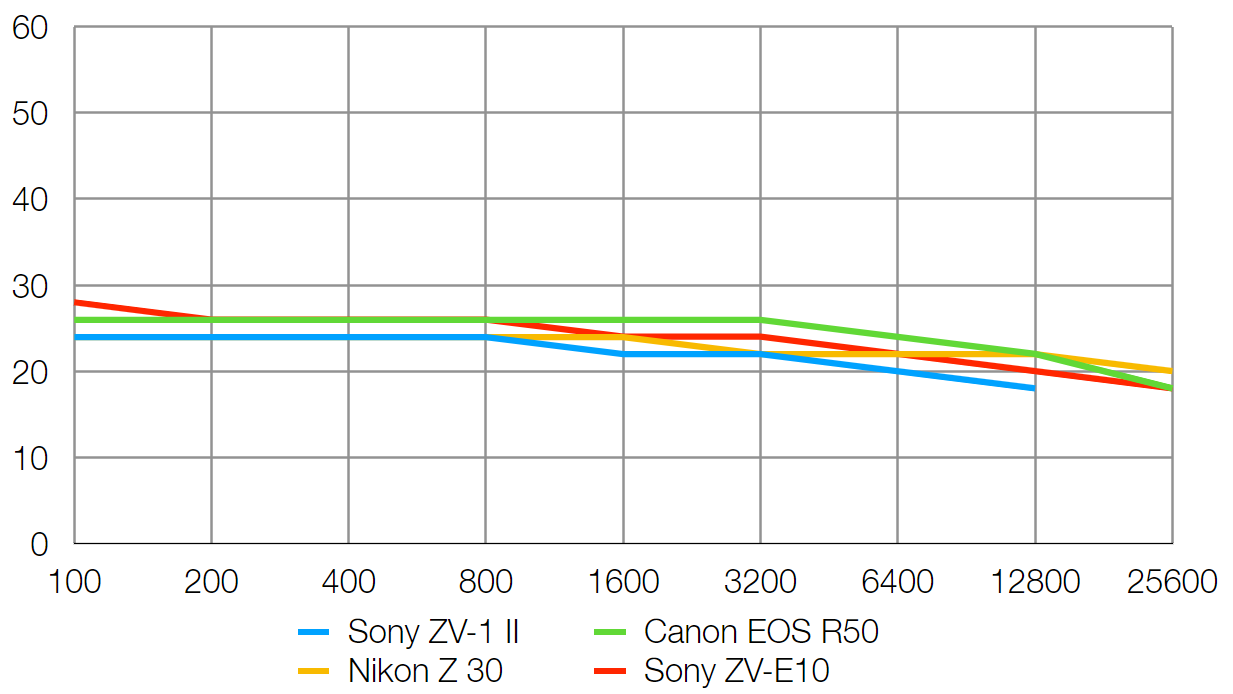
The closest competitor in terms of megapixels to the ZV-1 II is the 20.2MP Nikon Z30, but thanks to its larger APS-C sensor size, fine detail is slightly better defined. The 24MP Canon and Sony ZV-E10 resolve noticeably more detail than the ZV-1 II, though the difference isn't night and day.
Dynamic range (EV):
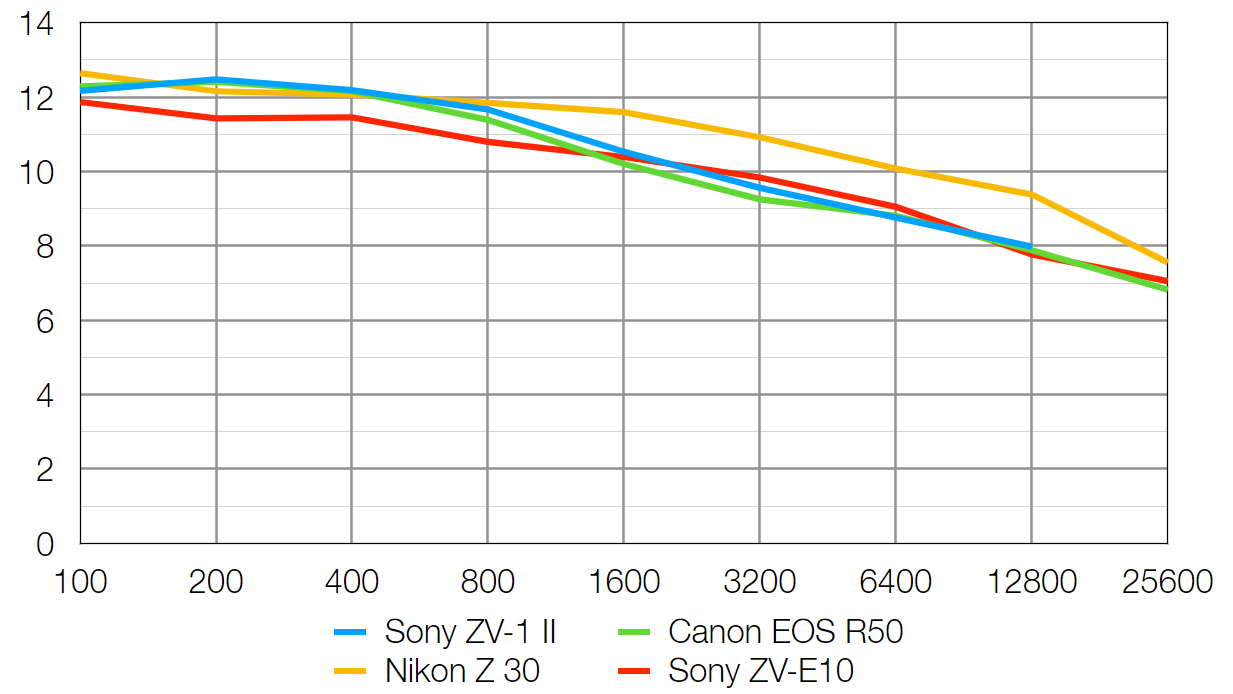
Despite its smaller sensor size, the ZV-1 II puts in a solid performance in our dynamic range test, equalling its APS-C rivals at lower snesitivities. Only the Z30 is able to clearly beat it, and even then only at higher sensitivities.
Signal to noise ratio (decibels):
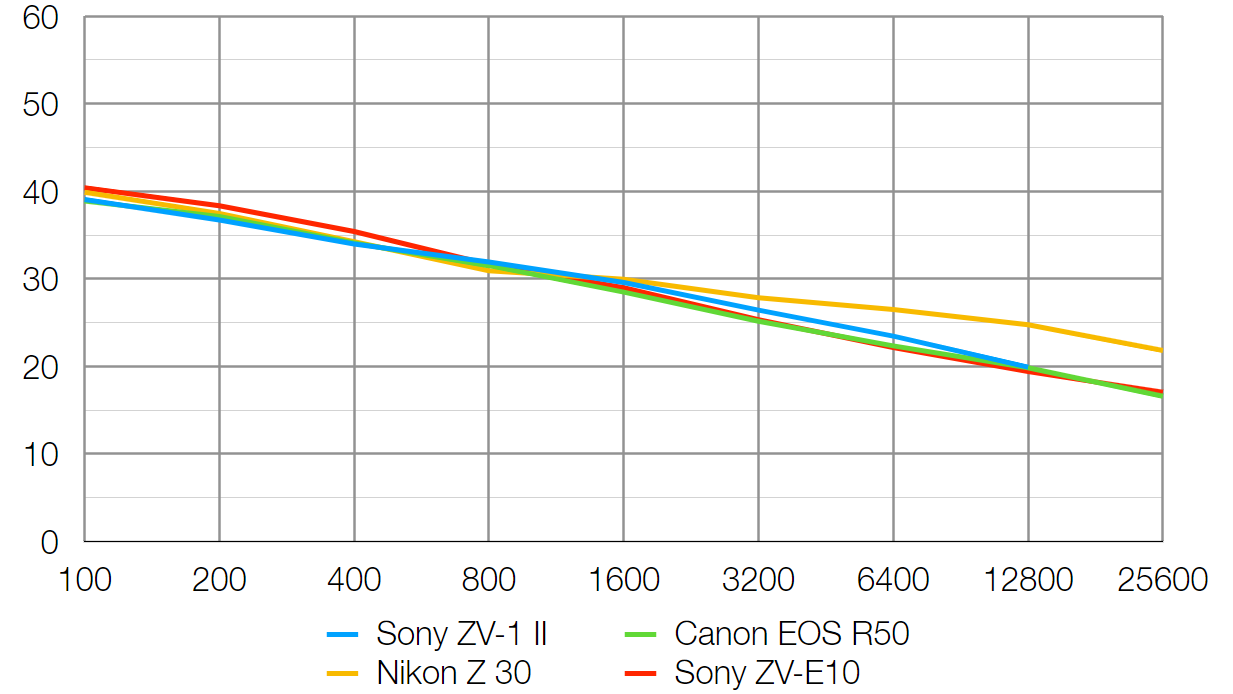
This test compares the amount of random noise generated by the camera at different ISO settings as a proportion of the actual image information (the 'signal'). Higher values are better and we expect to see the signal to ratio fall as the ISO is increased.
The ZV-1 II manages to equal the EOS R50 and ZV-E10 when it comes to image clarity and noise. Even though a 1.0-type sensor is significantly smaller than an APS-C sensor, it doesn't put the ZV-1 II at an obvious disadvantage in any of our lab tests.
Sony ZV-1 II: Verdict
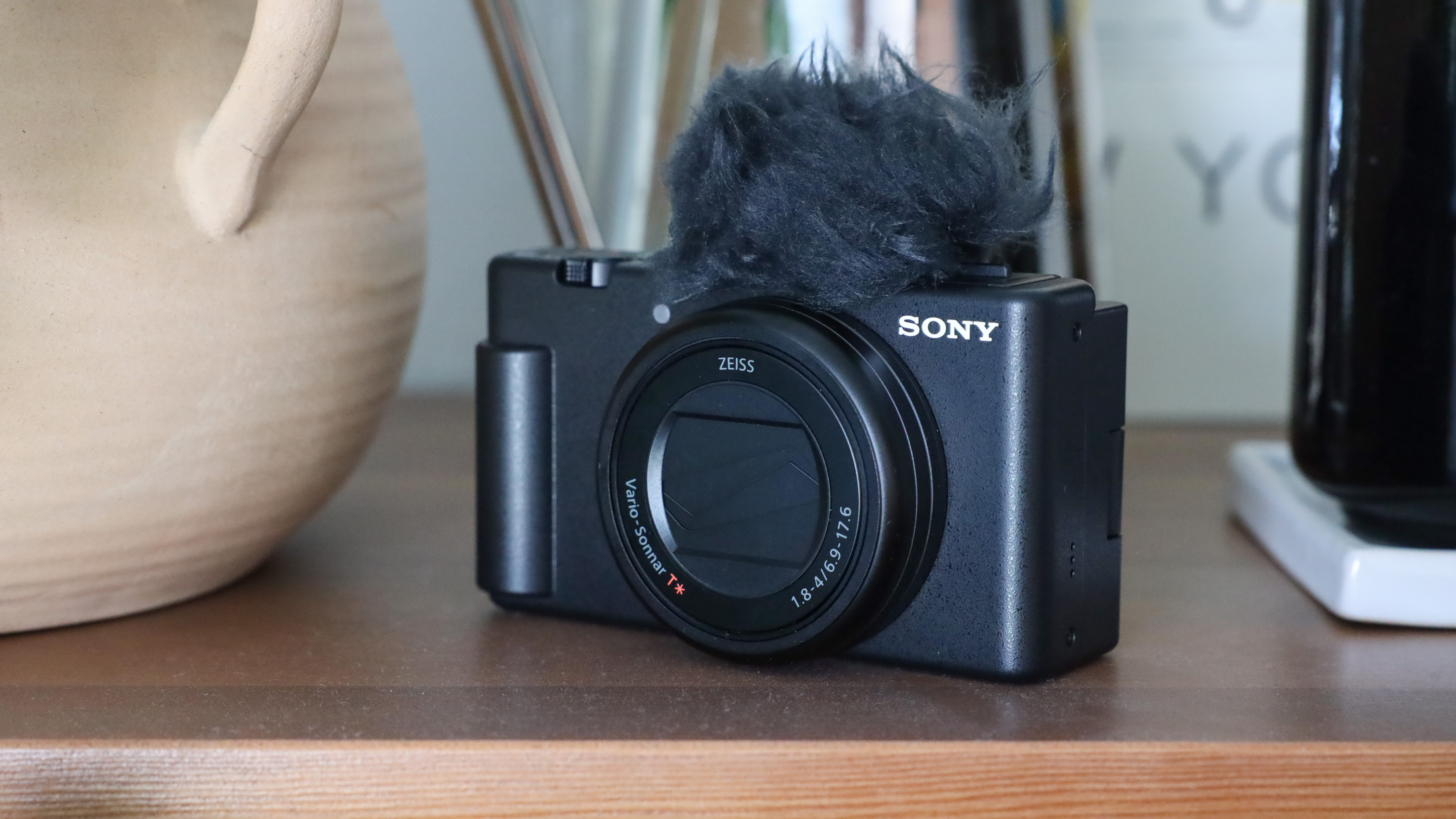
The ZV-1 II is a bit of a strange release for Sony, it doesn’t do nearly enough to separate itself from the model that came before, although Apple somehow gets away with the same thing every year, so maybe I should cut them a break. The ZV-1 II is more of an alternative model to the ZV-1 than an outright upgrade. Some people will prefer the wider zoom, now starting at 18mm, while others will prefer the extra focal length of the 24-70mm zoom on the original, which also has a wider aperture throughout the range, and I think this is where the decision will be made.
Sony have also decided to up the price by around $150 from the ZV-1 release, which puts it in the territory of also being just a little too expensive for what this camera is capable of. Sony seems to be banking on the compactness and simplicity of this camera convincing people to spend, however there are similar spec’d cameras out there for less money that offer more room to grow your creativity, if you are willing to compromise on size.
You might also like...
I have talked about the original ZV-1 enough, but there are several other cameras in the Sony ZV range that deserve consideration. The Sony ZV-E10 is essentially the Sony ZV-1 with a larger sensor and interchangeable lenses. Or going the other way, the Sony ZV-1F is a cheaper option that has a fixed 22mm lens.
If you definitely want to take a step up in sensor size, then a camera like Nikon Z30 is a great option with similar features and a lower price point. Sony also makes a series of cameras in its Sony a6000 series, which offer a much more hybrid shooting experience with more of a balance between photo and video.
Or for maybe the easiest vlogging experience with the least hassle, forgo the camera altogether and consider the iPhone 14 Pro Max, the current reigning champion of smartphone video.
Read More: find out some more of the best cameras for vlogging.







